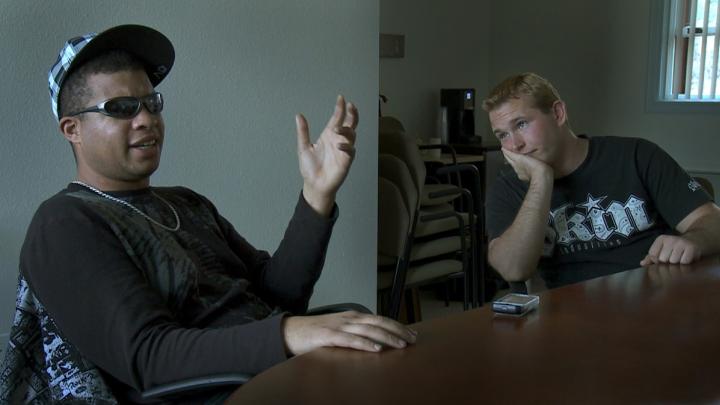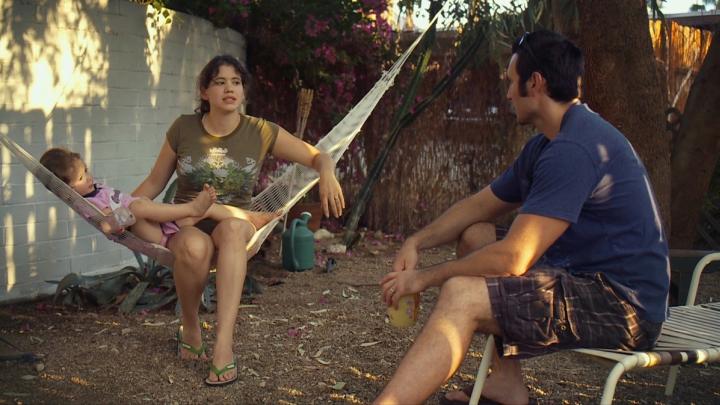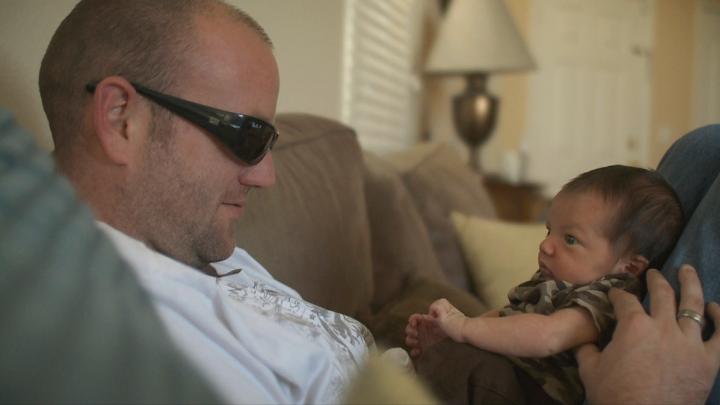As Of Men and War opens, a trumpet moans and won’t resolve into taps, and a van traps men who let it bounce them. They rarely come to town, they say. They are quick to road rage. They wear sunglasses. Later, one man tells his wife, “If we never had to leave the house, I’d be all right, but it’s going outside I can’t handle too much.”
The French documentary (released in many U.S. cities this week after playing at theaters in France and at international festivals), follows veterans of Iraq and Afghanistan as they undergo trauma therapy at a residential center called Pathway Home, founded by therapist Fred Gusman. These characters are archetypal—“almost mythological”—says Isidore Bethel ’11, the head editor for the film and one of its associate producers: “These men could have served in any war.” Their transposition into an older pantheon of suffering is nimble. The contemporary term “PTSD” is used exactly twice, once by a vet guilt-tripping a too-persistent caller and then by another vet’s wife. Otherwise, no character mentions diagnoses or pills, only men and death and their closeness to it.
Of Men and War is the second film in Laurent Bécue-Renard’s series A Genealogy of Wrath. As a young man, the director spent several months in besieged Sarajevo for “purely romantic” reasons. He found the city’s high pitch catching and vaguely familiar. There, while writing news dispatches and short stories, he met a therapist who worked with war widows. He focused on three of these women for his first documentary, War-Wearied (2003).
It dawned on him that a personal “quest” had drawn him to his project. His grandfathers served in the First World War, which killed some 1.7 million French, about 5 percent of the country’s population. “All of us who grew up in the second half of the twentieth century inherited the legacy of the wars in the first part of the twentieth century,” Bécue-Renard said. “It has been shaping the psyches of the families we belong to.”
When he first visited Pathway, in Yountville, California, in 2008, he shared the tale of his grandfathers with the veterans as part of a project to earn their trust. This took five months. He felt his foreignness helped. His voice betrayed no bias of class, hometown, or education, though one vet did call him “Frenchie.” He spoke English but lacked fluency in the automatic cues Americans trade—“I don’t have preconceived perception of the English language, because I don’t have the same conscious experience of the English language which I have in French”—and hoped to see the men humanly. He rented a room next to the center and visited almost every day, earning a volunteer’s badge and finally his own key. He met a hundred men and focused the film on 12 who seemed as if they’d benefit from the camera’s amplification of their therapy. He considered it natural not to share their last names. “This kind of project, you only have one shot,” he said. “You can’t miss it…the day you start filming,” by putting off the subjects. During the nine months that he filmed therapy, he said, no man asked him to stop.
While at Pathway, Bécue-Renard took yoga with the men and took them to the town’s French bakery for espressos, which were new to them, and, once invited, sat with them for lunch. He did not ask them questions. Continuing a technique he had developed for War-Wearied, he let his camera align with the therapist’s axis of view during the group-therapy sessions. The viewer thus participates, too. “Therapy is a creative process,” Bécue-Renard said: “the invention of a story.” The camera affirms to the vets that their stories have worth and meaning, or at least theme and arc. In one scene, Gusman reassures them, “These are real-live memories. It’s part of who you are. And it will take time to give it new meaning.”
Between 2009 and 2013, Bécue-Renard visited the men to film them at home in California, Tennessee, Nevada, and Hawaii. He shot the therapy sessions with a high-definition lens but filmed these scenes of home and families with a 35-mm lens, giving them a hazy glow associated with fiction film. Wives address their vets in luminous backyards. Trees and tiger lilies wreathe one of them; yellow light gilds her green eyes as she plucks a vermillion cherry tomato and tosses it toward his mouth. He misses. In a similarly lush scene, birdsong accompanies the recollection of a medic: “Saving the guys that didn’t want to live, not saving the guys that wanted to live… It would’ve been a hell of a lot easier to just have fallen down over there and not gotten back up.” Technicolor glamor thwarts these men whose minds are battlescapes.
When Bethel joined the project in 2012, he began by watching the roughly 500 hours of footage. At the time, he was living in the Eighteenth Arrondissement; each morning he would bike to the cramped offices of the production company, Alice Films, on the rue du Bac, watch maybe eight or 10 hours of footage alone, and bike home. He had been working on a documentary of his own for two years, As Long as it Would Take to Live It, about a childhood friend, his best friend, who died in an accident just after they graduated from college, and it had bogged him down.
Recently Bethel, who is a friend, told me, “It was pretty overwhelming, to spend between eight and 10 hours a day with men who were at the extreme of one part of life and death. Men who are asking at every single moment, Is death going to take me today? Or tomorrow? Or, Is my friend going to die?” Over time, he says, “Things got a lot more meaningful once I started constructing stories out of this raw footage…I started to see how this brutal trauma fit into the arcs of these men’s lives.”
Though his friend had died under different circumstances, Bethel says, “The guilt, the loss, the shame, the anger that these veterans felt, I felt small echoes of in my own life, and this made me invested in working to help them express it in ways that were powerful, and also helped me express those feelings with the characters in my film.” He is now finishing As Long as it Would Take to Live It and is also at work on a video exhibition, Long Coil of War, that would allow visitors to browse clips from those 500 hours of therapy and assemble them into narratives that would let further personal meaning emerge.
“You wouldn’t have trauma at all if you didn’t have to deal with the death issue,” says one vet in the group-therapy room. “I mean, the act of having to cause death, or harm, or almost dying, or seeing it.”Another brings up “the death issue” thus: “It’s kinda hard being married, it’s kinda hard being close to anyone, because you know they’re going to leave.”
In these ways, the vets seem a million years old. Most were between 21 and 25.
Bethel was the only young man, as well as the only American, to work on the film. Only vagaries of chance like class and education had kept him from its subjects’ fate. For practical reasons, a native speaker of American English had to be the one to splice this dialogue: the characters speak American argot, frequently poetic, with a grammar of pain:
He’s goin’ in the Glad bag
That whole eye trick thing tryna close the fucking eyes
That’s why I don’t sleep / ’Cause if you sleep what?
Not to break your fucking mood or nothing but
I’ve come real close, real close, real close
I open the back of the highback and when I open it, blood just comes pouring out
These lines issue from scenes composed in close shots. The therapy room traps the viewer as it trapped the viewed, between high-def gooseflesh-textured white walls. Daylight pools relentlessly on an oblong table of composite wood. The vets have tells. A man’s neck reddens, apparently from the effort of speaking. Another man moves his right arm in twitching circles. He jiggles a leg. The viewer welcomes these distractions. Another man describes a face afire, and the camera on him is unremitting as we look elsewhere, anywhere, our only options blue stubble, a mole, a shock of white: the stripe of track pants.
An accomplishment of this film is making us see as the veterans do. Boys performing a baseball drill drop onto the pitch as if shot. A palm tree bristles above the center’s roof as if to hide a sniper. One daughter’s car-seat straps resemble a bulletproof vest. One imagines the French director hard-pressed for workarounds to avoid the on-set verb “to shoot.” Making stories—in therapy and in film—helped the veterans and the filmmakers. Similarly, we can bear seeing in this way, empathizing with such trauma, thanks to the promises of cinema: release us after two hours’ traffic, call it a wrap, offer the gift of ending.
A way out claims thousands of veterans a year who fall victim to suicide, according to the Department of Veterans Affairs. When one vet, Chris, graduates from Pathway, he accepts a yellow rose and offers a strange speech to the other men: “First off, I just wanted to say, you know, I’ve been very fortunate for the time I’ve had here at Pathway, but unfortunately, this isn’t really where it starts. From the time I got injured, I knew something was wrong. Things are going real bad for me, so I just wanted to acknowledge my mother, she put up with me when I couldn’t deal with myself.” The scene ends then, and then the music of flutes rises behind a desert highway that speeds past the camera. At the time, the news of the suicide reached Bécue-Renard through Facebook. Later he received an e-mail from Chris’s mother granting permission for the death to be included in the film.
Despite the film’s universality, some images locate Of Men and War in a specific nation. These include a Fourth of July parade, a pancake griddle, and a diet yogurt with a spoon at half-mast. But the ones that feel most American convey space. The American West, which fascinates the French, spreads vast as ever here: a house is built cheaply and tall as a granary. Bodies are corn-fed and red. That moonscape is a supermarket parking lot. Frame after frame shows the American West as an embarrassment of space, a cruelty of space. The film’s drama unspools between this open world and those close trenches of trauma, the mind.
The vets’ sunglasses block and less often, reflect this bright world. It filters to their senses only painfully. A man says, in group therapy, “Before we just get started, I just wanna say that I have earplugs in…” Two small girls formerly separated from their fathers because of the men’s displaced rage warble and murmur and are told, “Use your words.” Once loosed from the crucible of group, the vets at Pathway sleep, snore, wear furry slippers, and are indulged when they indicate a pancake with the point and grunt of a boy. Their wives line their own eyes in kohl. The kohl looks like sunglasses, too. The sunglasses leave tan lines, visible in high-definition shots of therapy. The shield itself can scar. Untold stories, or their repression, can do harm. Though that alternative is worse, storytelling is hard. Of Men and War gives the lie to sayings that entreat turning “toward the light,” as the progression of the protagonists is all in light, fighting the glare, from discomfort to comfort or at least peace.












